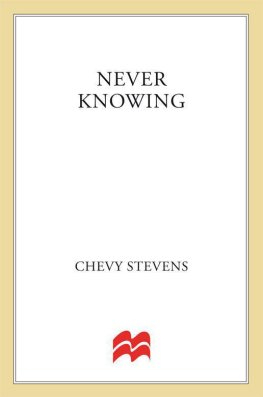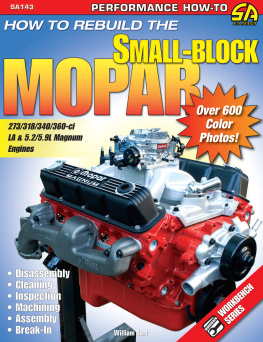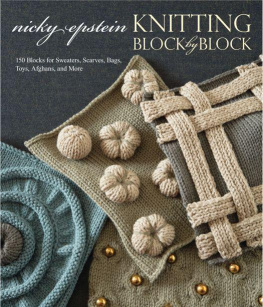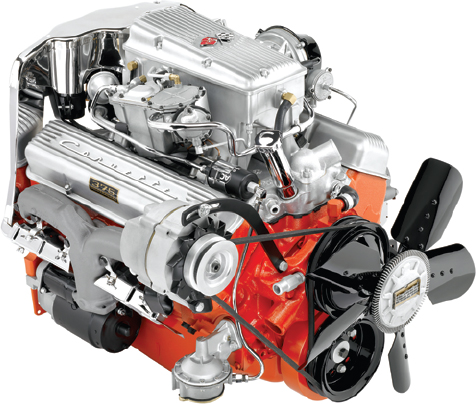
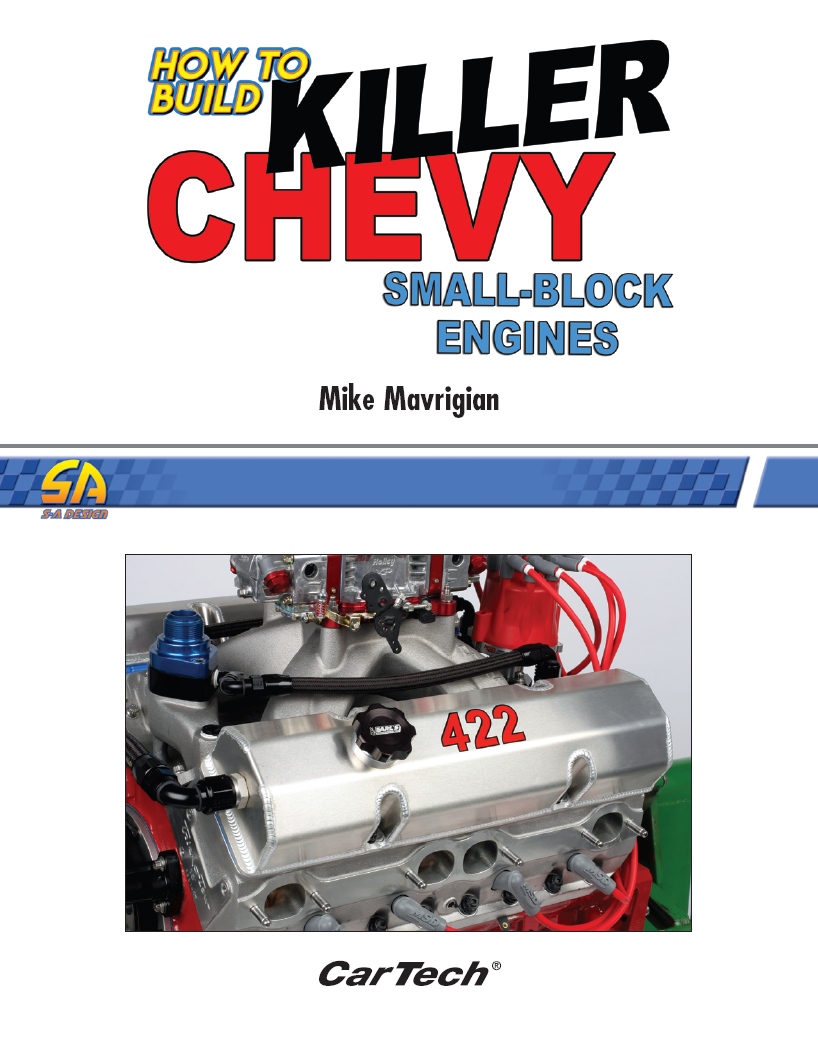

CarTech, Inc.
838 Lake Street South
Forest Lake, MN 55025
Phone: 651-277-1200 or 800-551-4754
Fax: 651-277-1203
www.cartechbooks.com
2019 by Mike Mavrigian
All rights reserved. No part of this publication may be reproduced or utilized in any form or by any means, electronic or mechanical, including photocopying, recording, or by any information storage and retrieval system, without prior permission from the Publisher. All text, photographs, and artwork are the property of the Author unless otherwise noted or credited.
The information in this work is true and complete to the best of our knowledge. However, all information is presented without any guarantee on the part of the Author or Publisher, who also disclaim any liability incurred in connection with the use of the information and any implied warranties of merchantability or fitness for a particular purpose. Readers are responsible for taking suitable and appropriate safety measures when performing any of the operations or activities described in this work.
All trademarks, trade names, model names and numbers, and other product designations referred to herein are the property of their respective owners and are used solely for identification purposes. This work is a publication of CarTech, Inc., and has not been licensed, approved, sponsored, or endorsed by any other person or entity. The Publisher is not associated with any product, service, or vendor mentioned in this book, and does not endorse the products or services of any vendor mentioned in this book.
Edit by Bob Wilson
Layout by Hailey Samples
ISBN 978-1-61325-489-9
Item No. SA456
Library of Congress Cataloging-in-Publication Data Available
Written, edited, and designed in the U.S.A.
Printed in China
10 9 8 7 6 5 4 3 2 1
CarTech books may be purchased at a discounted rate in bulk for resale, events, corporate gifts, or educational purposes. Special editions may also be created to specification.
For details, contact Special Sales at 838 Lake Street S., Forest Lake MN 55025 or by email at .
DISTRIBUTION BY:
Europe
PGUK
63 Hatton Garden
London EC1N 8LE, England
Phone: 020 7061 1980 Fax: 020 7242 3725
www.pguk.co.uk
Australia
Renniks Publications Ltd.
3/37-39 Green Street
Banksmeadow, NSW 2109, Australia
Phone: 2 9695 7055 Fax: 2 9695 7355
www.renniks.com
Canada
Login Canada
300 Saulteaux Crescent
Winnipeg, MB, R3J 3T2 Canada
Phone: 800 665 1148 Fax: 800 665 0103
www.lb.ca
CONTENTS
ACKNOWLEDGMENTS
Thanks to the following for their participation and input: Zac Kimball and Chris Raschke, ARP; Bill McKnight, Mahle; Ron Rotunno, Fel-Pro; Sean Crawford, JE Pistons; Tom Lieb, Scat Enterprises; Don Meziere, Meziere Enterprises; Mike Osterhaus, Melling Select; Cody Smith, Cloyes; Jodi Holtrey, Medina Mountain Motors; Scott Gressman, Gressman Powersports; Tony Lombardi, Ross Racing Engines; Bill Tichenor and Jeff Teel, Holley and MSD Performance; Silver Gomez, MSD Performance; John Callies, John Callies Inc./Morel Lifters; Richard Maskin, Dart; Jack McKinnis, World Products; Dick Boyer, World Products/Erson-PBM; Trent Goodwin, Comp Cams and RHS; Duane Boes, Callies Crankshafts; Air Flow Research; Al Rebescher, Trick Flow Specialties; Bob Fall, Fall Automotive Machine; Glen Schierholt, UEM/Icon Pistons; Swain Tech Coatings; Thor Schroeder, Moroso Performance; Lynn Livermore, Fluidampr; Bullet Cams; Permatex; Dave Monyhan, Goodson Shop Supplies; Ryan Kilpatrick, Oliver Rods; Tom Lieb and Alex Gonzalez, Scat Crankshafts; Jennifer Woods, Brodix; Randy Becker, Harland Sharp, CJ Jones, Jones Racing; Rob Remesi and Mike Mullen, Jesel; Robin Manton, Manton Pushrods; Wilson Intake Manifolds; Jim Smaaladen, Bryant Crankshafts; Kathy Donovan, Donovan.
CHAPTER 1
THE SMALL-BLOCK CHEVY
Hot dogs, baseball, apple pie, the flag, Mom, and the small-block Chevy engine. Collectively, were talking about all things America. Shortly after the birth of the performance industry to the present day, the beloved SBC (small-block Chevy) continues to be one of the most, if not the most, prolific and intensely-developed, go-to engine platform in the performance and racing communities.
The first small-block Chevy engine was introduced in 1955 and was available in the Bel Air and Corvette in 265 cubic inches of displacement. Small-block engines, featuring a cylinder bore spacing of 4.40 inches, produced from 1955 to 1974 were referred to as Turbo-Fire or High Torque engines. The 350-ci engine, one of many iterations of the platform, was introduced in 1967 and helped the small-block Chevy become one of the most popular platforms for performance use. The 350 is widely considered as the standard platform for the small-block family.
The 265-ci engine debuted in 1955 and was the foundation for decades of performance that followed. (Photo Courtesy GM Media Archives)
The 1965 327-ci engine with fuel injection is shown. The Rochester Ramjet fuel injection system was first offered as a high-performance option on the Corvette and GM passenger cars in 1957. It was discontinued partway through 1965 in favor of the Chevrolet big-block as a performance option. This is a purely mechanical system, unlike modern electric systems today. (Photo Courtesy GM Media Archives)
Shortly after the debut of the small-block engine, the aftermarket began introducing components that were primarily designed to work with the OEM factory blocks to improve performance. Beginning with upgrades to camshafts, intake manifolds, carburetors, and tubular exhaust headers, hot rodders and racers began to experience and enjoy substantial performance improvements. This continued with upgraded cylinder heads in both cast iron and aluminum, forged pistons of various dome configurations, superior ignition components, stronger valvetrain components, stronger connecting rods, stronger crankshafts, stronger main caps, different crank strokes and connecting rod lengths, etc.
As racers continued to stretch the engine speed and load parameters, weak links that became apparent were quickly addressed, resulting in increasingly stronger parts in addition to components and systems that offered power enhancements. Since those early days, the small-block Chevy engine became firmly established as the standard of performance engines for street rodders, drag racers, oval track racers, and road racing competition. Aftermarket manufacturers also began producing stronger engine blocks that offered superior strength, rigidity, and cooling, in addition to providing the ability to increase cylinder bore diameters and to accept longer crankshaft strokes. In the effort to reduce weight and to improve cooling, aluminum blocks became available for specific racing applications.
Next page




